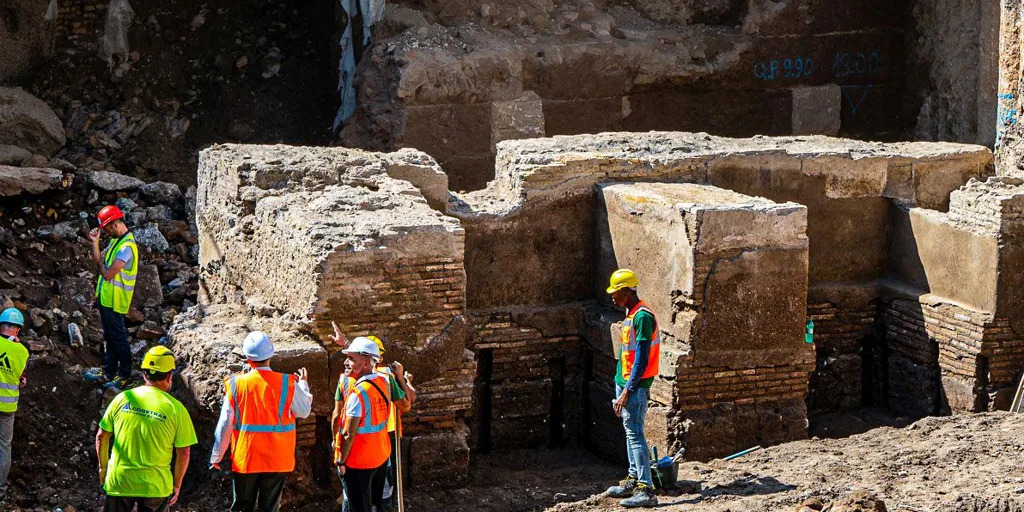Emperor Caligula’s Portico Discovered Steps From St. Peter’s Square

Rome The upside is down with countless tasks in mind for the 2025 anniversary. It is not surprising that, as always when digging is done eternal Citynew wonders emerge from the underground. This is what happened with the project , Pedestrianization of Piaś SquareLocated a few steps away, between Castel Sant’Angelo and Via della Conciliazione St Peter’s Square. What now comes to light on the banks of the Tiber River is Caligula’s Porchthe third Roman emperor, who ruled from 37 AD to 41 AD, the date of his death. It is a structure formed by a travertine ‘opus quadratum’ wall, a construction system of ancient Rome, in which thick stone blocks of equal height are placed. Behind this wall, a portico with columns was built, of which only the foundations remain, and a large open space was arranged as a garden, delimited by a series of river terraces formed by the Tiber.
Excavations have allowed us to document how the complex was affected Three phases of construction This happened between the time of Augustus and Nero. A lead water pipe (lead fistula used in ancient Rome) has been discovered, in a relatively good state of preservation, bearing Caligula’s name. The inscription appears as C(ai)cesaris Aug(usti) Germanici: Therefore, this Caligula is Gaius Julius Caesar, born on August 31, year 12; he was the third of six children born from the marriage of Agrippina the Elder – granddaughter of the emperor Augustus – and Germanicus, who in turn was the adopted son of the emperor Tiberius and one of the greatest generals of ancient Rome.
As highlighted Alessio De Cristofaroarchaeologist Special Superintendence of RomeThe inscription on the water pipe is of great historical importance for several reasons. First, it confirms how the excavation took place Pia Square is framed within the area ofHorti of Agrippina‘ (where the old Nero Theatre was also found last year), the gardens owned by the mother of Caligula. In addition, its Pia Square with names of other lead pipes Julia Augustapossibly Livia Drusillathe second wife of Augustus and grandmother of Germanicus. Therefore, it is possible that this luxurious residence was inherited first by Germanicus and then, after his death, by his wife Agrippina the Elder and then by their emperor son.
This discovery may also find interesting confirmation in ancient literary sources, according to a note by Ministry of Culture. An excerpt from the section ‘From Embasseria to Gio,Legatio ad Gaiam), works written by Philo of AlexandriaA Jewish historians from Alexandria (Egypt), which describes a monumental portico and explains how Caligula A delegation of Jews from Alexandria was received at the same time Agrippina GardensIn a huge garden overlooking the Tiber.
In addition, some Campana reliefs (also called Campana slabs) appeared in the excavations, that is, terracottas with reliefs used for the decoration of roofs, representing unusual mythological scenes, probably made to cover the same portico, and later reused as covers for the pipes of theFullonica‘, the Latin term refers to a laundry and dry cleaning shop, very important in Roman times. Precisely, these latest archaeological remains discovered were located under an old laundry that also came to light in recent weeks. Their employees were ‘Fuloni‘, that is, the workers who in ancient times were in charge of washing clothes, removing stains and preparing clothes. The toga especially required the work of the Fuloni; hence the widespread spread of this profession.
Remains of the ‘fullonica’ pipe
Ministry of Culture, Italy
with the tasks of Pia Square An underpass is being constructed for traffic movement at this nerve centre. Rome.but first with the discovery of the old laundry and then with the discovery of the veranda Caligulathere is a risk that tasks will be delayed. They should be completed first 24 Decemberthe day of the beginning Jubilee. To avoid delays in a construction area that is right ahead via della conciliazioneWork shifts are set up to operate 24 hours per day. AnasThe company responsible for the works ensures that the time will be respected. One can imagine that they will pray to St. Peter so that new archaeological remains do not come to light that would further delay the work, as usually happens with excavations. eternal City,
